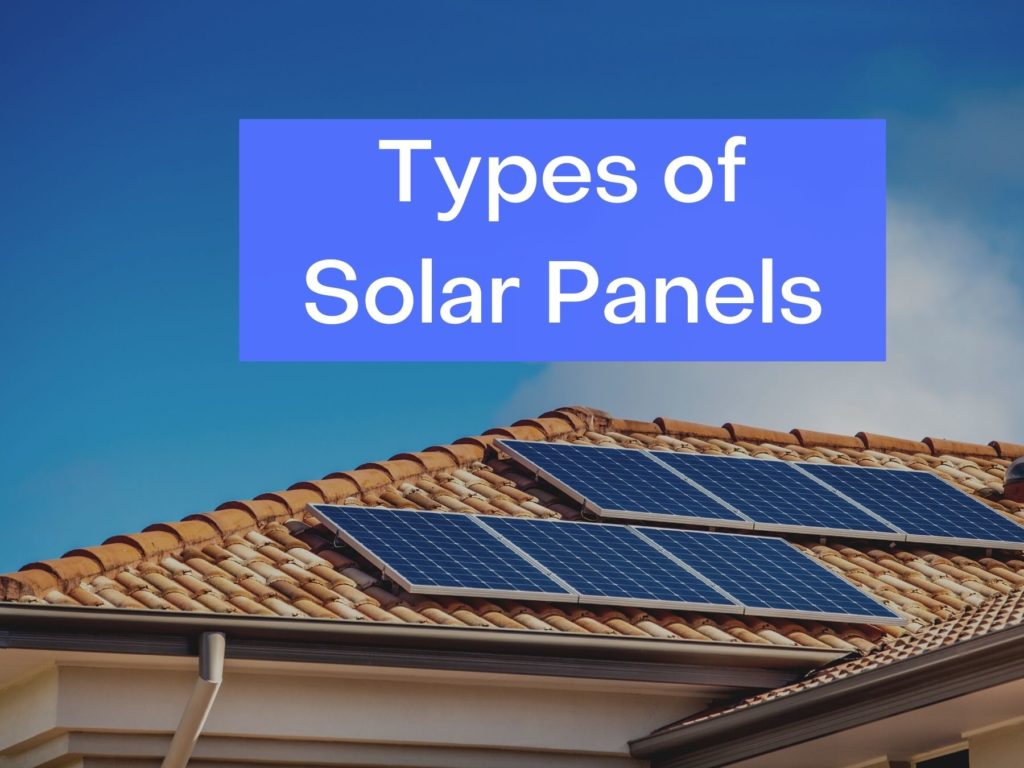We have different types of solar panels on the market today. These solar panels differ based on their efficiency, build-material, looks, and performance.
There are countless benefits to installing a solar system in your home. Many people often consider aesthetics, cost, and efficiency when installing solar panels.
However, there is a more important factor to consider, which is the type of solar panels. The solar panel type determines the other factors like aesthetics, cost, and more.

Here are the three different types of solar panels and how they function:
1. Monocrystalline Solar Panel
Monocrystalline panels are one of the most popular solar panels, and they are also known as single-crystalline silicon. These panels are made from a pure silicon crystal, and you can quickly identify them by their dark black color. Monocrystalline solar panels are the most durable and space-efficient among the different solar panels, thanks to their build materials.
They are the most developed and oldest type of solar panel. These solar panels have black cells because sunlight interacts with the silicon crystal. However, monocrystalline solar panels come in different colors for their frames and back sheets despite having black cells. Most models come with white, silver, or black back sheet, while the frame is often silver or black.
The efficiency rate of monocrystalline solar panels is between 15 and 22 percent. These panels have an even crystal framework, making them highly efficient. However, monocrystalline solar panels do not come cheap. They used a lot of silicon in the manufacturing process, so it is more expensive than the other types.
Furthermore, these panels have an excellent heat resistance, which helps extend their life span. Their heat-resistance feature does not affect their effectiveness. They have a pyramid pattern, increasing their surface area for improved solar energy absorption.
2. Polycrystalline Solar Panels
Polycrystalline solar panels are also efficient but not as efficient as monocrystalline solar panels. These panel types are relatively new, but they are increasingly becoming popular. Polycrystalline solar panel cells are also made of silicon. Nevertheless, they are made with silicon crystal fragments melted together.
When manufacturing it, they placed the silicon crystal in a vat of molten silicon. Rather than slowly pulling it out, they allowed the crystal to fragment and cool. After they get cooled, they thinly slice the fragmented silicon into polycrystalline solar wafers. After the process, they assembled the wafers to form the polycrystalline panel.
The surface of these panels is often blue because of how light interacts with crystals. The way sunlight reflects on the silicon fragments is different from how it reflects on pure silicon cells. Like monocrystalline solar panels, the frames and back of polycrystalline solar panels come in different colors.
Another notable difference between polycrystalline and monocrystalline solar panels is that the former has square shapes with no gaps between the edges of the cells like that of monocrystalline panels.
Polycrystalline solar panels are second in the hierarchy when it comes to efficiency. They boast of an efficiency rating from 13 to 16 percent. These solar panels also have lower heat resistance, making them less efficient in environments with very high temperatures. One of the significant advantages of polycrystalline solar panels is that they are more eco-friendly. They also have a less expensive manufacturing process, as they consume less silicon.
3. Thin-Film Solar Panels
Thin-film solar panels are the least efficient of the three types of solar panels. These panels are mainly used to power appliances that require less power. Their manufacturing process is also easy and less expensive. These panels appear flexible, allowing for effortless installation. You can mount them on rooftops without any issues.
Thin-film solar panels are not always made of silicon. Different manufacturers use different materials to make them, including amorphous silicon, cadmium telluride, and copper indium gallium selenide. They make these panels by placing the critical material between thin conductive materials. The top of the panel is sealed with glass for protection.
Thin-film solar panels are thin, and you can identify them by their appearance. Thin-film panels are about 350X thinner than panels made with silicon wafers. The color of these panels also varies depending on the material used. It is worth noting that thin-film cells are ultra-thin, but the entire panel might be as thick as a polycrystalline or monocrystalline panel. Thin-film solar panels have a 7 to 13 percent efficiency rating in terms of efficiency.
Learn the Working Principle of Solar Panels here.
Summary
There are three major types of solar panels on the market today. However, these panels differ in performance, cost, efficiency, and appearance. When it comes to performance, monocrystalline solar panels are the best; they have a higher energy efficiency rating than the other two panel types. The second most efficient is polycrystalline, while the third is thin-film solar panels.
The most expensive are monocrystalline solar panels when it comes to cost, as they feature a more expensive manufacturing process. The second most costly is polycrystalline panels, while the least costly is thin-film solar panels.
Finally, thin-film panels are the most attractive when it comes to appearance. They feature a very thin and sleek design that makes them easy to install. Monocrystalline panels are the second most beautiful, while the least attractive are polycrystalline panels.